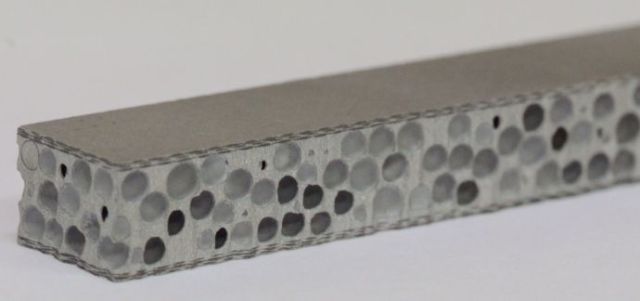A collaborative research team has conducted a series of revolutionary tests on a layered material with a lightweight metal matrix syntactic foam core. The team was led by Nikhil Gupta, a NYU School of Engineering associate professor in the Department of Mechanical and Aerospace Engineering, working with the Toledo, Ohio company Deep Springs Technology, and the U.S. Army Research Laboratory.
 Lightweight metal matrix syntactic foam between two carbon fabric layers, offering extreme light weight, flexibility, and the ability to withstand deformation and absorb energy.
Lightweight metal matrix syntactic foam between two carbon fabric layers, offering extreme light weight, flexibility, and the ability to withstand deformation and absorb energy.
This material will likely find application in trains, ships, automobiles and other applications where lightweight structural parts, capable of retaining their strength even after being compressed or bent, are in high demand.
Traditional metal foams contain gas-filled pores within the metal. Although these do reduce weight, they also pose certain difficulties, such as the ability to control the pores’ shape and size during manufacturing. On the other hand, porosity is integrated into metal matrix syntactic foams in their foam-like structure through use of hollow particles.
These materials have become increasingly sought after in the last few years due to their compressive strength. Bending strength, however, was still a drawback in several applications, especially in automotive structures.
Earlier metallic foams were placed between two stiff sheets, which provided additional flexural strength, while the foam core provided the material with the ability to handle large deformation, as well as absorb energy.
Gupta’s team is the first to create a metal matrix syntactic foam core sandwich composite. The team used an aluminum alloy packed with hollow alumina particles, which was placed between carbon fabric face-sheets. The layered material they created was lighter in weight, as well as stiffer, with high energy absorption. These exceptional features are very useful for automotive floor board panels, and other applications where bending properties are vital.
“This work could result in a new generation of ships and ground vehicles for both the military and civilian sectors,” says Gupta. “Trains can also benefit from the lightweight and high energy absorbing panels made possible by the new sandwich composite.”
The team has published their findings in Materials Science and Engineering: A.